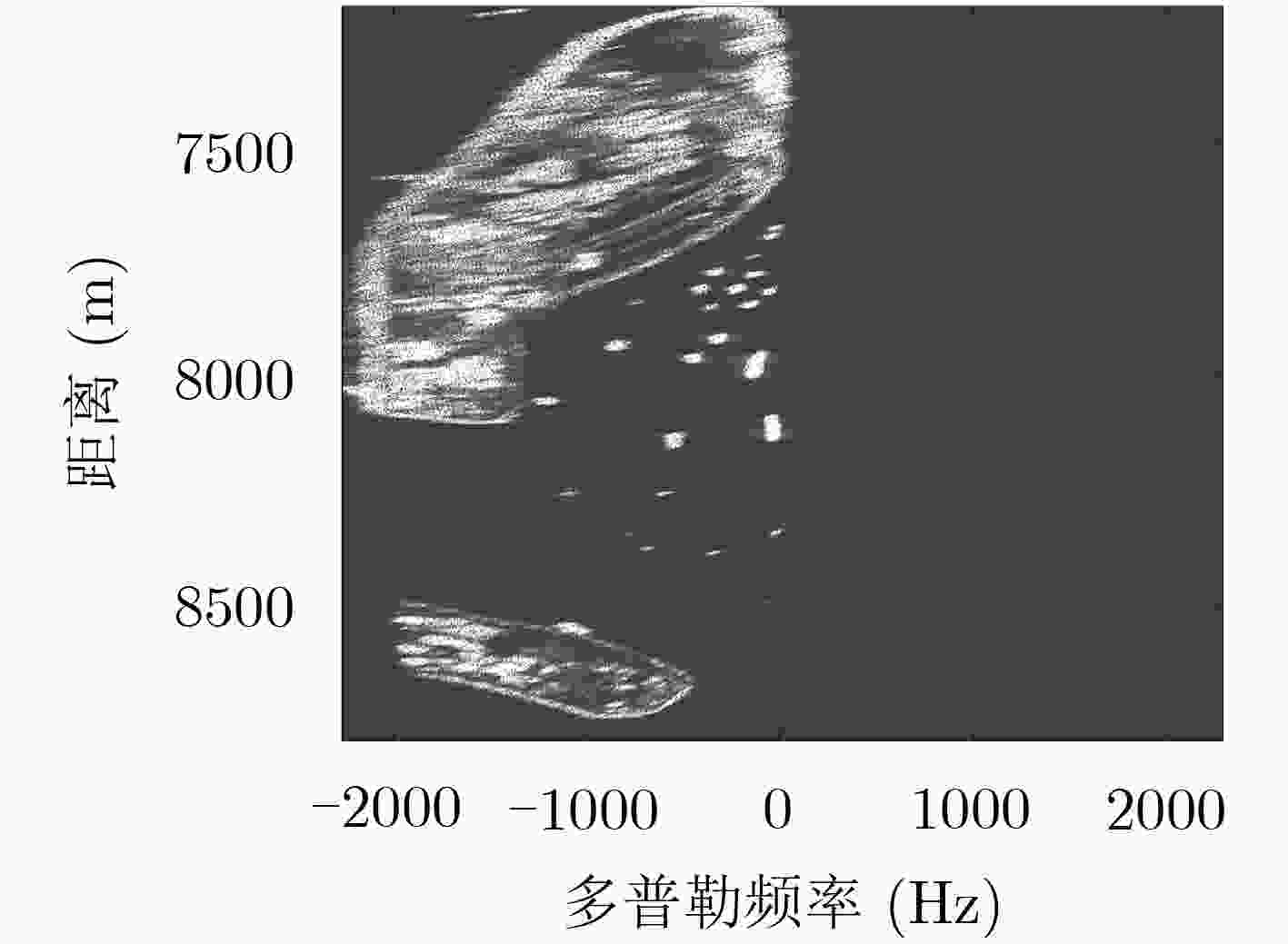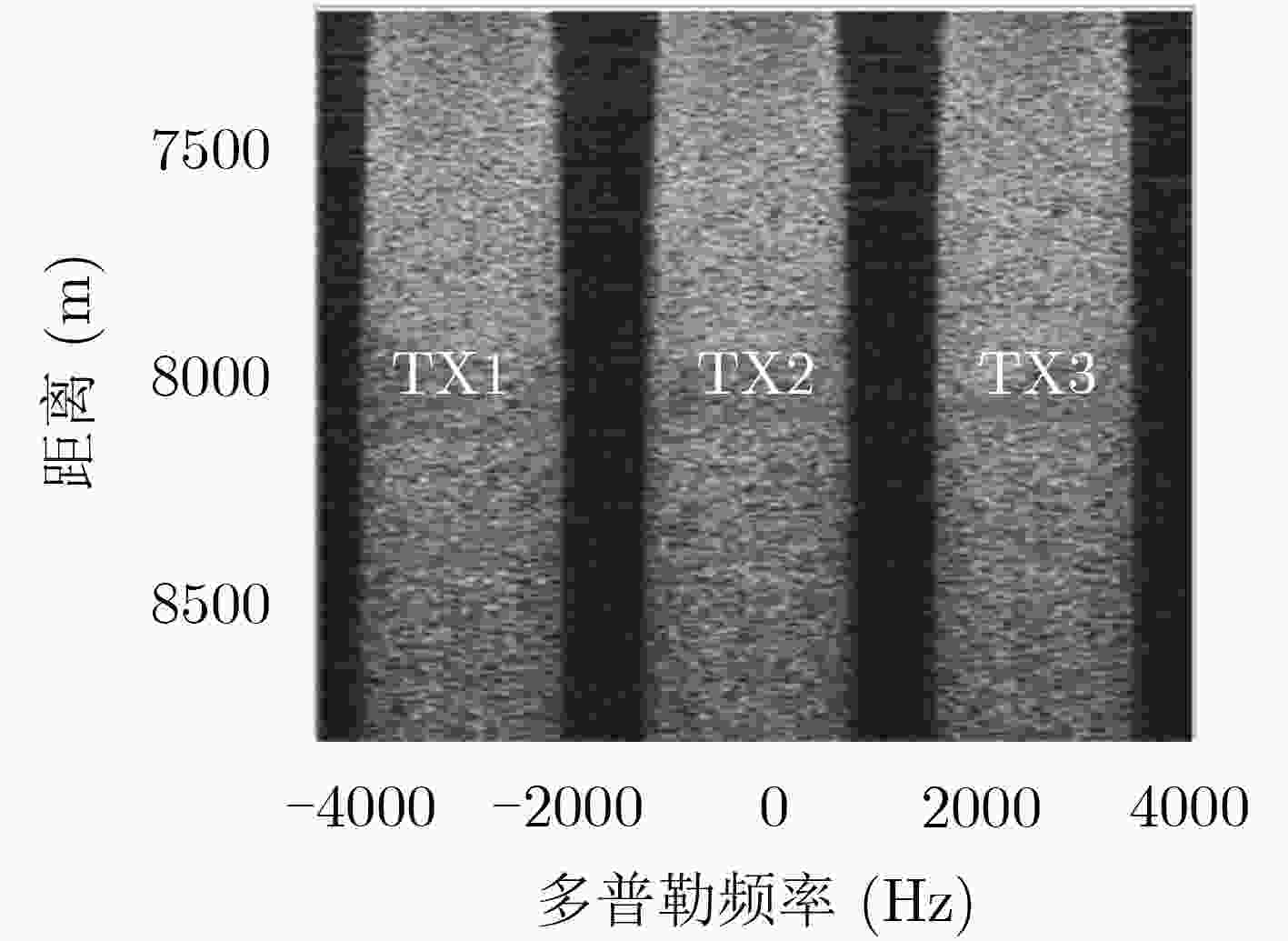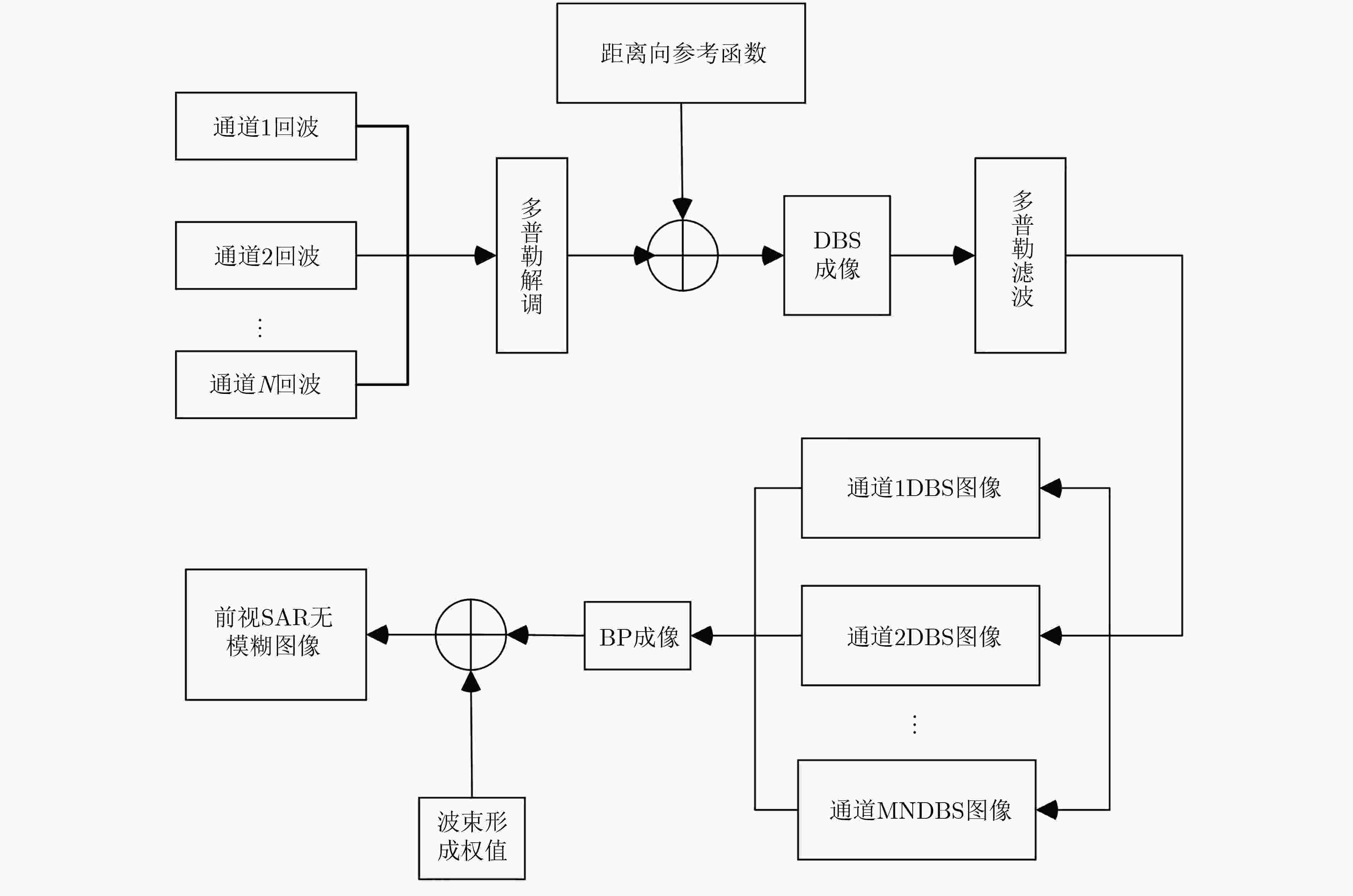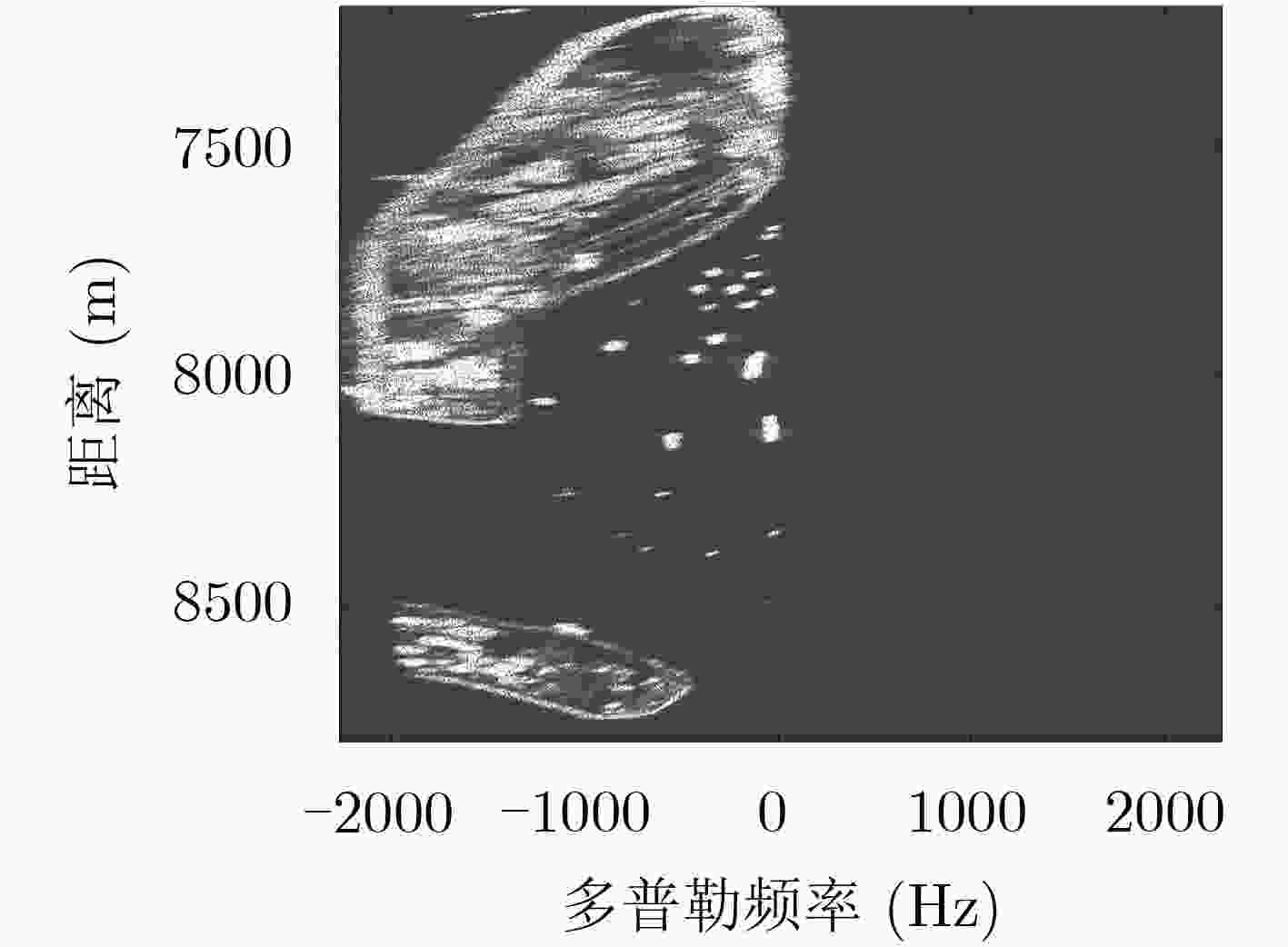Imaging Technology of Doppler Diversity Forward-looking SAR Imaging for Unmanned Aerial Vehicle
-
摘要: 前视合成孔径雷达(SAR)成像存在多普勒左右模糊的问题,需要利用空域资源进行解模糊处理。限于无人机(UAV)的载重与尺寸,接收阵列通常较小,解多普勒模糊的空域波束形成能力不足。此外,前视SAR回波方位多普勒梯度小、带宽窄,使得接收带宽未被充分利用。基于以上问题,该文提出多普勒分集前视SAR成像方法。该算法在前视SAR成像技术的基础上,利用多普勒分集MIMO技术,将多普勒窄带前视回波调制于不同多普勒中心以达到充分利用多普勒接收带宽的目的。进而,可获得一个数倍于真实接收阵列孔径的虚拟接收阵列,极大地扩展了接收通道,有效地改善了前视SAR成像解多普勒左右模糊的性能。Abstract: Forward-looking Synthetic Aperture Radar (SAR) imaging has the problem of left-right Doppler ambiguity, so it is necessary to use spatial resources for ambiguity resolution. Due to the weight and size of Unmanned Aerial Vehicle (UAV), the receiving array is usually small, and the ability of spatial beam-forming for Doppler ambiguity resolution is insufficient. In addition, the small Doppler gradient and narrow bandwidth of forward-looking SAR echo make the receiving bandwidth underutilized. Based on the above problems, a Doppler diversity Multiple Input Multiple Output (MIMO) forward-looking SAR imaging method is proposed. Based on the forward-looking SAR imaging technology, the narrow-band forward-looking Doppler echo is modulated to different Doppler centers by using Doppler diversity MIMO technology to make full use of the Doppler receiving bandwidth. Furthermore, a virtual receiving array with several times the aperture of the real receiving array can be obtained, which expands greatly the receiving channel and improves effectively the performance of forward-looking SAR imaging in de-Doppler left-right ambiguity.
-
表 1 仿真参数设置
参数 数值 参数 数值 载频 35 GHz 脉冲重复频率 9 kHz 信号带宽 50 MHz 波束方位宽度 20° 脉冲宽度 0.5 μs 波束俯仰宽度 22° 采样带宽 60 MHz 场景中心斜距Rs 8 km 平台高度 4000 m 阵列实孔径长度 0.0642 m -
高许岗, 雍延梅. 无人机载微型SAR系统设计与实现[J]. 雷达科学与技术, 2014, 12(1): 35–38. doi: 10.3969/j.issn.1672-2337.2014.01.006GAO Xugang and YONG Yanmei. Design and realization of UAV high resolution miniature SAR[J]. Radar Science and Technology, 2014, 12(1): 35–38. doi: 10.3969/j.issn.1672-2337.2014.01.006 赵博, 钱正祥, 黄晓雷. 无人机载SAR技术应用研究综述[J]. 安徽电子信息职业技术学院学报, 2009, 8(1): 24–25. doi: 10.3969/j.issn.1671-802X.2009.01.011ZHAO Bo, QIAN Zhengxiang, and HUANG Xiaolei. Survey on UAV-borne SAR techniques’ application[J]. Journal of Anhui Vocational College of Electronics &Information Technology, 2009, 8(1): 24–25. doi: 10.3969/j.issn.1671-802X.2009.01.011 SUTOR T, BUCKREUSS S, KRIEGER G, et al. Sector imaging radar for enhanced vision (SIREV): Theory and applications[C]. The 2000 European Conference on Synthetic Aperture Radar, Munich, Germany, 2000: 357–359. 卢景月, 张磊, 王冠勇. 前视多通道合成孔径雷达解模糊成像方法[J]. 电子与信息学报, 2018, 40(11): 2820–2825. doi: 10.11999/JEIT180177LU Jingyue, ZHANG Lei, and WANG Guanyong. Ambiguity resolving and imaging algorithm for multi-channel forward-looking synthetic aperture radar[J]. Journal of Electronics &Information Technology, 2018, 40(11): 2820–2825. doi: 10.11999/JEIT180177 卢景月, 张磊, 孟智超, 等. 曲线轨迹下前视多通道SAR解模糊成像算法[J]. 航空学报, 2019, 40(6): 322745. doi: 10.7572/S1000-6893.2019.22745LU Jingyue, ZHANG Lei, MENG Zhichao, et al. Unambiguous imaging for forward-looking synthetic aperture radar on curve trajectory[J]. Acta Aeronautica et Astronautica Sinica, 2019, 40(6): 322745. doi: 10.7572/S1000-6893.2019.22745 包敏, 周鹏, 史林. 双天线前视弹载SAR解模糊算法研究[J]. 电子与信息学报, 2013, 35(12): 2857–2862. doi: 10.3724/SP.J.1146.2013.00083BAO Min, ZHOU Peng, and SHI Lin. Study on deambiguity algorithm for double antenna forward looking missile borne SAR[J]. Journal of Electronics &Information Technology, 2013, 35(12): 2857–2862. doi: 10.3724/SP.J.1146.2013.00083 武其松, 井伟, 邢孟道, 等. MIMO-SAR大测绘带成像[J]. 电子与信息学报, 2009, 31(4): 772–775. doi: 10.3724/SP.J.1146.2007.01959WU Qisong, JING Wei, XING Mengdao, et al. Wide swath imaging with MIMO-SAR[J]. Journal of Electronics &Information Technology, 2009, 31(4): 772–775. doi: 10.3724/SP.J.1146.2007.01959 GONG Min, WANG Xiaoming, and HUANG Shunji. Performance improvements in MIMO SAR[C]. 2008 IEEE Radar Conference, Rome, Italy, 2008: 1–3. doi: 10.1109/RADAR.2008.4720969. CHIZHIK D, FOSCHINI G J, GANS M J, et al. Keyholes, correlations, and capacities of multielement transmit and receive antennas[J]. IEEE Transactions on Wireless Communications, 2002, 1(2): 361–368. doi: 10.1049/el:20000828 FOSCHINI G J and GANS M J. On limits of wireless communications in a fading environment when using multiple antennas[J]. Wireless Personal Communications, 1998, 6(3): 311–335. doi: 10.1023/A:1008889222784 GESBERT D, BOLCSKEI H, GORE D A, et al. Outdoor MIMO wireless channels: Models and performance prediction[J]. IEEE Transactions on Communications, 2002, 50(12): 1926–1934. doi: 10.1109/TCOMM.2002.806555 FISHLER E, HAIMOVICH A, BLUM R, et al. MIMO radar: An idea whose time has come[C]. 2004 IEEE Radar Conference, Philadelphia, USA, 2004: 71–78. ENDER J H G. MIMO-SAR[C]. The International Radar Symposium, Cologne, Germany, 2007: 580-588. 禹卫东, 李红霞. MIMO-SAR回波分离方法分析[J]. 数据采集与处理, 2014, 29(4): 533–541. doi: 10.3969/j.issn.1004-9037.2014.04.007YU Weidong and LI Hongxia. Analysis of echo separation in MIMO-SAR[J]. Journal of Data Acquisition and Processing, 2014, 29(4): 533–541. doi: 10.3969/j.issn.1004-9037.2014.04.007 BLISS D W, FORSYTHE K W, DAVIS S K, et al. GMTI MIMO radar[C]. 2009 International Waveform Diversity and Design Conference, Kissimmee, 2009: 118–122. 任笑真, 杨汝良. 机载前视SAR三维成像算法研究[J]. 电子与信息学报, 2010, 32(6): 1361–1365. doi: 10.3724/SP.J.1146.2009.00734REN Xiaozhen and YANG Ruliang. Study on three-dimensional imaging algorithm for airborne forward-looking SAR[J]. Journal of Electronics &Information Technology, 2010, 32(6): 1361–1365. doi: 10.3724/SP.J.1146.2009.00734 -






 下载:
下载:










 下载:
下载:
